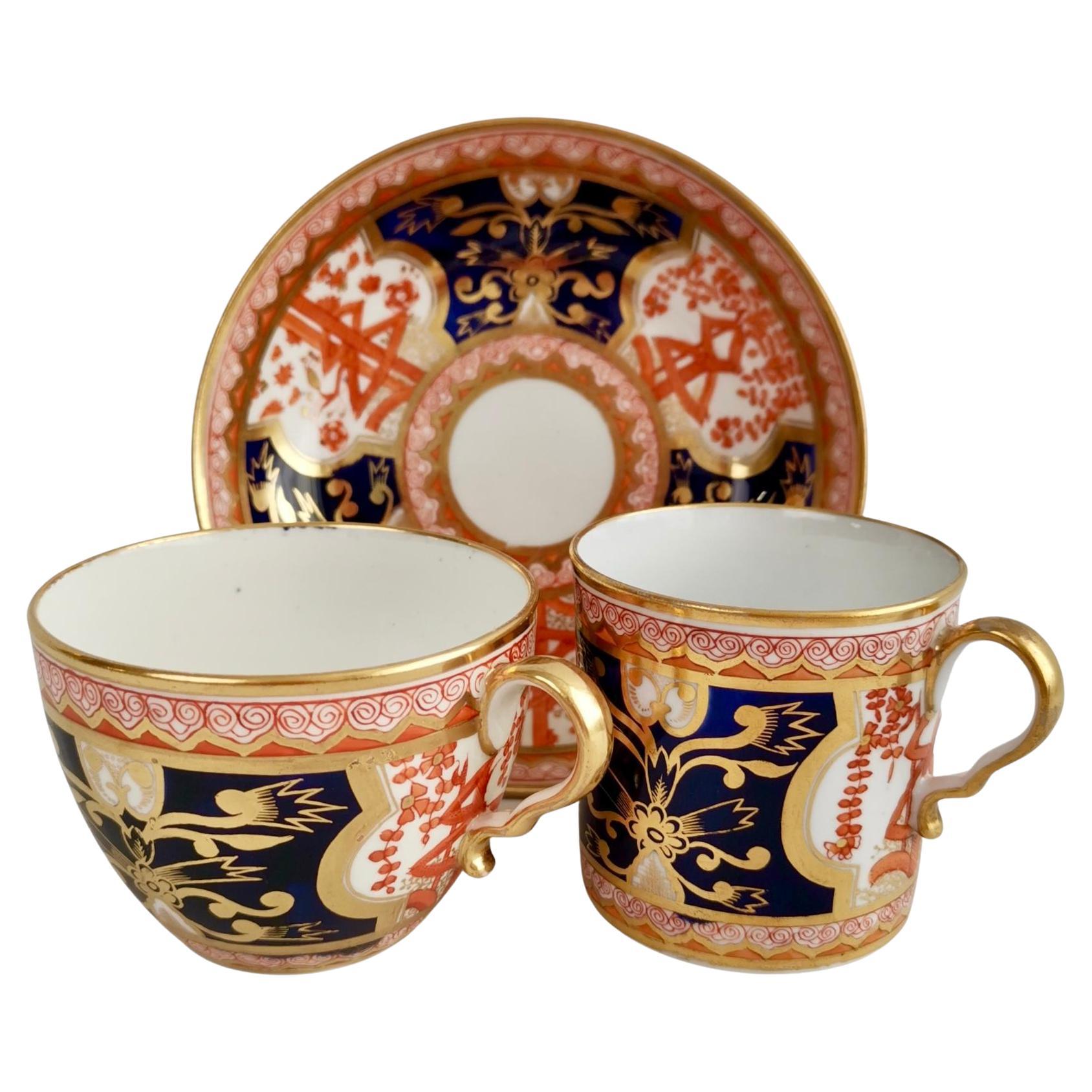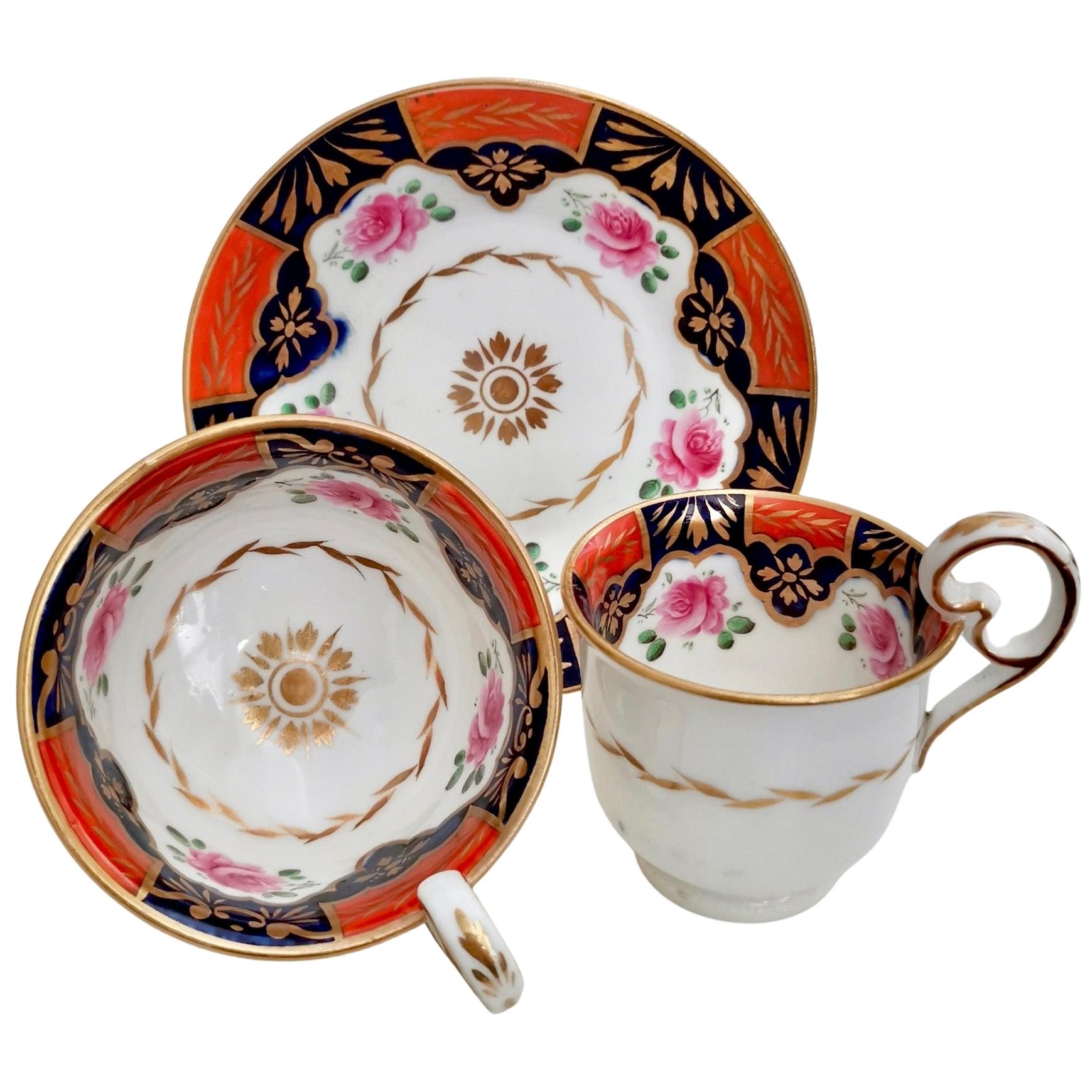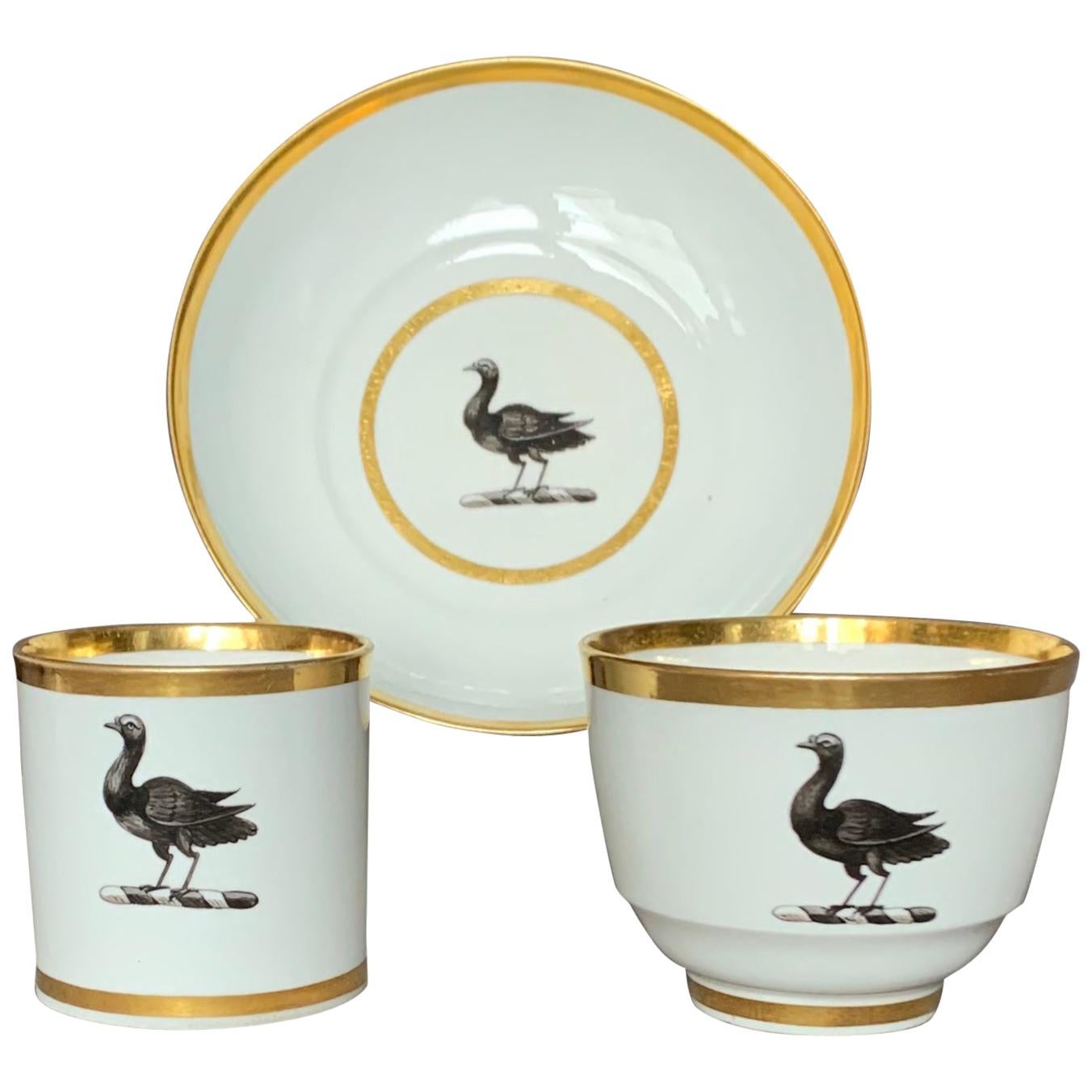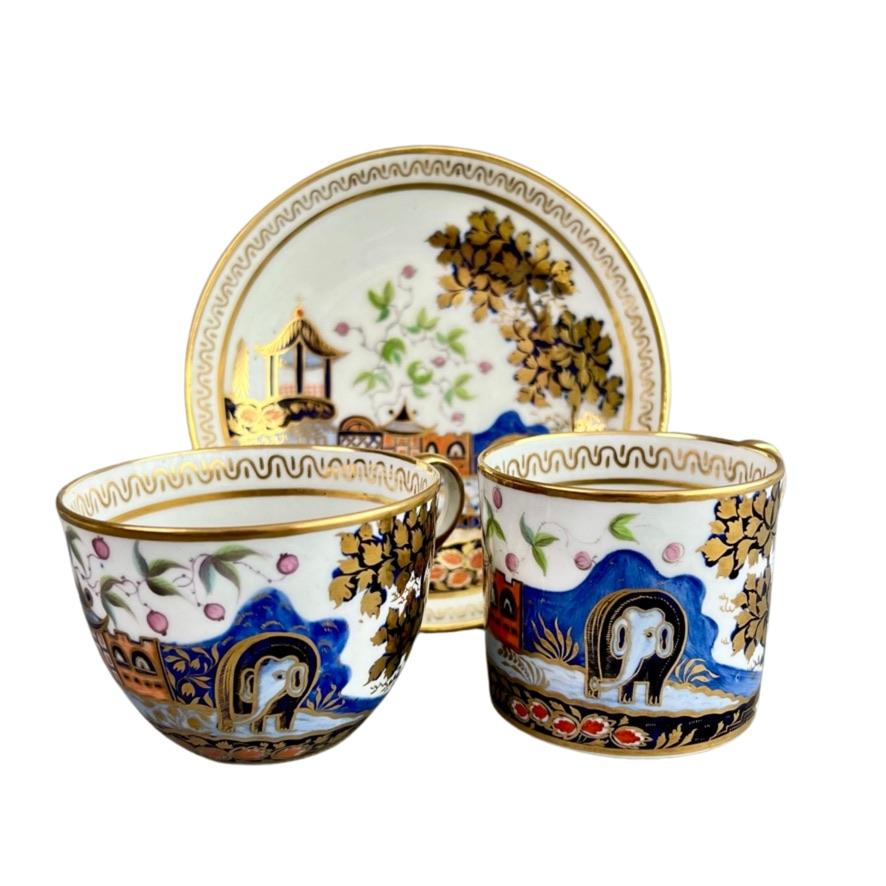Items Similar to Derby Porcelain Teacup Trio, Green with Red Flowers, 1800-1810
Want more images or videos?
Request additional images or videos from the seller
1 of 16
Derby Porcelain Teacup Trio, Green with Red Flowers, 1800-1810
About the Item
This is a wonderful "true trio" made by the Derby Porcelain factory between 1800 and 1810. The trio is decorated in an overglaze green ground with cheerful red flowers.
In the late 18th and early 19th Century cups and saucers were sold as trios of a teacup and coffee cup sharing one saucer - as you would never drink tea and coffee at the same time, why invest in an extra saucer?
The Derby Porcelain factory has its roots in the late 1740s, when André Planché, a Walloon Huguenot refugee, started making simple porcelain toys shaped like animals. Local entrepeneur William Duysbury took an interest in his skills and worked with him to improve the quality of his wonderfully shaped items. Together they laid the foundations of what would become a very refined tradition of figure making at Derby. In 1769 Duysbury bought up the bankrupted Chelsea factory, incorporating their reputation for high quality figures and tableware; this combination of traditions, porcelain making skills, sophisticated clients and available work people created one of the best porcelain factories of the 18th and 19th Centuries, which after many ups and downs is still operative today.
This set is nicely potted; the teacup has a straight bucket shape and the coffee cup is a coffee can; coffee cups only came into fashion a little later. The handles are square and flat "French" handles.
This set must have been owned by a coffee drinker, as the coffee cup handle and rim have a lot more wear than the teacup; you can see how the gilt consisted of red pigment mixed with gilt as there is a pink residue. It is also possible that the coffee can simply wasn't fired as well so the gilt may have worn off more easily.
The set is marked with the red crowned hand painted Derby mark.
Condition Report The set is in very good antique condition without any damage, crazing or repairs, but it has wear, as visible in the pictures.
Antique British porcelain is never perfect. Kilns were fired on coal in the 1800s, and this meant that china from that period can have some firing specks from flying particles. British makers were also known for their experimentation, and sometimes this resulted in technically imperfect results. Due to the shrinkage in the kiln, items can have small firing lines or develop crazing over time, which should not be seen as damage but as an imperfection of the maker's recipes, probably unknown at the time of making. Items have often been used for many years and can have normal signs of wear, and gilt can have signs of slight disintegration even if never handled. I will reflect any damage, repairs, obvious stress marks, crazing or heavy wear in the item description but some minor scratches, nicks, stains and gilt disintegration can be normal for vintage items and need to be taken into account.
There is widespread confusion on the internet about the difference between chips and nicks, or hairlines and cracks. I will reflect any damage as truthfully as I can, i.e. a nick is a tiny bit of damage smaller than 1mm and a chip is something you can easily see with the eye; a glazing line is a break in the glazing only; hairline is extremely tight and/or superficial and not picked up by the finger; and a crack is obvious both to the eye and the finger.
Dimensions (diameters) teacup 9.2cm (3.6), coffee can 6.5cm (2.5"); saucer 14.2cm (5.5").
- Creator:Derby (Maker)
- Dimensions:Height: 1 in (2.54 cm)Width: 1 in (2.54 cm)Depth: 1 in (2.54 cm)
- Sold As:Set of 3
- Style:Regency (Of the Period)
- Materials and Techniques:
- Place of Origin:
- Period:
- Date of Manufacture:1800-1810
- Condition:Wear consistent with age and use. In very good antique condition without any damage, crazing or repairs; some wear throughout as visible in the pictures.
- Seller Location:London, GB
- Reference Number:
About the Seller
5.0
Gold Seller
These expertly vetted sellers are highly rated and consistently exceed customer expectations.
Established in 2016
1stDibs seller since 2019
208 sales on 1stDibs
Typical response time: 1 hour
- ShippingRetrieving quote...Ships From: London, United Kingdom
- Return PolicyA return for this item may be initiated within 14 days of delivery.
More From This SellerView All
- Spode Porcelain Teacup Trio, Red Imari Dollar Pattern, Regency, ca 1810By SpodeLocated in London, GBThis is a beautiful orphaned teacup made by Spode in about 1810. It bears a beautiful Japanese-inspired Imari pattern. Spode was the great pioneer among the Georgian potters in England. Around the year 1800 he perfected the bone china recipe that has been used by British potters ever since, and he was also the leading potter behind the technique of transferware, making it possible for English potters to replace the Chinese export china, which had come to an end around that time, with their own designs. This was fundamental to a thriving industry that would last for about 150 years and provide half the world with their tableware. Spode porcelain is regarded as one of the highest quality porcelains around; for a soft-paste porcelain it is surprisingly hard and fine, and has a wonderful bright white colour. The pattern on this can is called "Dollar" pattern, a very famous pattern that was used by English potters in the 18th and early 19th Century. It is obvious why it is called “dollar” - but its origin is less obvious! It is thought that this pattern was derived from a very old Chinese pattern depicting a tree with elaborate foliage that hides a Chinese character representing longevity or happiness. Traditionally, this went with a an image called “Taotie”, which was used on very ancient bronze vases...Category
Antique Early 1800s English Regency Porcelain
MaterialsPorcelain
- Spode Porcelain Teacup Trio, Lavender Blue with Flower Sprays, Regency ca 1815By SpodeLocated in London, GBThis is a beautiful "true trio" consisting of a teacup, a coffee cup and a saucer, made by Spode in about 1815. It is decorated with pattern 2234 with a striking lavender or periwinkle blue border and finely painted flower sprays. In the late 18th and early 19th Century a "true trio" is how cups and saucers were sold; as you would never drink tea and coffee at the same time, why invest in an extra saucer? Josiah Spode was the great pioneer among the Georgian potters in England. Around the year 1800 he perfected the bone china recipe that has been used by everyone ever since, and he was also the leading potter behind the technique of transferware, making it possible for English potters to replace the import of Chinese china that had come to an end around that time, with their own. This was fundamental to a thriving industry that would last for about 150 years and provide half the world with their tableware. This set is made in the famous "London" shape, which was brought out by Spode in 1812 and was quickly copied by all other makers. It then remained the most popular shape for about 10 years. The set is potted in fine white porcelain - by the year 1810 Spode had perfected his recipe for bone china and it became beautifully smooth, white, thin and translucent. All three items are marked with the red hand painted SPODE mark and the pattern number 2234. CONDITION REPORT The set is in excellent antique condition without any damage, repairs or crazing. There is some minimal wear as visible in the pictures...Category
Antique 1810s English Regency Porcelain
MaterialsPorcelain
- Bloor Derby Porcelain Breakfast Cup with Plate, Gilt with Purple Flowers, Ca1825By Derby, Bloor DerbyLocated in London, GBThis is a very charming "breakfast" teacup and saucer with a plate, made by Derby / Bloor Derby between 1806 and 1825. It is likely that the set was potted between 1806 and 1825, then decorated and brought to the market around 1825. A breakfast cup is a large teacup...Category
Antique 1820s English Regency Porcelain
MaterialsPorcelain
- Coalport Porcelain Teacup Trio, Orange with Roses, Regency, circa 1820By Nantgarw China WorksLocated in London, GBOn offer is a beautiful and rare "true trio" made by Coalport in about 1820. The trio has a beautiful Regency shape with heart shaped handles. This pattern is unusual and very rare....Category
Antique 1820s Welsh Regency Tea Sets
MaterialsPorcelain
- New Hall Hybrid Hard Paste Teacup Trio, Elephant Pattern, Regency ca 1810By New HallLocated in London, GBThis is a beautiful true trio made by New Hall around the year 1810. The set is decorated in the very desired but rare Elephant pattern. A true trio is how cups and saucers were sol...Category
Antique 1810s English Regency Tea Sets
MaterialsPorcelain
- Minton Porcelain Teacup Trio, Bath Embossed White with Sepia Roses, Regency 1830By MintonLocated in London, GBThis is a rare and beautiful trio consisting of a teacup, coffee cup and saucer, made by Minton in circa 1830. Minton was one of the pioneers of English china production alongside...Category
Antique 1830s English Regency Tea Sets
MaterialsPorcelain
You May Also Like
- Set of Six Porcelain Bird Teacup TriosBy Flight, Barr & Barr WorcesterLocated in New York, NYSet of six porcelain bird teacup trios. Strikingly modern looking antique set of six BFB Worcester trios of six teacups and six coffee cups with six sh...Category
Antique Late 18th Century English Empire Tea Sets
MaterialsPorcelain
- Early Derby Porcelain Coffee Can att. to George Robertson, circa 1795By Derby, George RobertsonLocated in Fort Lauderdale, FLA green-ground porcelain coffee can made by the Derby Porcelain Factory circa 1795. This green-ground coffee can is a fine example of early Derby porcelain...Category
Antique 1790s English Georgian Porcelain
MaterialsPorcelain
- Four Antique Meissen Teacups with Saucers in Hand-Painted PorcelainLocated in Copenhagen, DKFour antique Meissen teacups with saucers in hand-painted porcelain. Purple flowers and gold decoration. Museum quality, approx. 1740. The cup meas...Category
Antique 1740s German Porcelain
MaterialsPorcelain
- Bjørn Wiinblad for Rosenthal, Lotus Porcelain Service, 9 Teacups with SaucersLocated in Copenhagen, DKBjørn Wiinblad for Rosenthal. Lotus porcelain service. 9 teacups with saucers decorated with pink lotus leaves. 1980s. The cup measures: 10 x 5 c...Category
Vintage 1980s German Modern Porcelain
MaterialsPorcelain
- Rörstrand, Sweden, a Set of Eleven Art Nouveau Porcelain Teacups with SaucersLocated in Copenhagen, DKRörstrand, Sweden. A set of eleven Art Nouveau porcelain teacups with saucers. hand painted with motifs of purple flowers. Approx. 1910s. In excellent condition. First factory quality. Marked in red...Category
Vintage 1910s Swedish Art Nouveau Porcelain
MaterialsPorcelain
- Six Royal Copenhagen Frijsenborg Teacups with Saucers in Hand-Painted PorcelainLocated in Copenhagen, DKSix Royal Copenhagen Frijsenborg teacups with saucers in hand-painted porcelain with flowers and gold edge. 1950s. The cup measures: 10 x 5 cm. Sa...Category
Vintage 1950s Danish Porcelain
MaterialsPorcelain
Recently Viewed
View AllMore Ways To Browse
Vintage Set Squares
Tea Set For One
Antique Tea Cans
Stained Glass Green
Flowers Used For Tea
Antique Tea Sign
Drinking Tea
Antique Chinese Tea Sets
Antique Chinese Tea Set
Antique China Tea Sets
Antique China Tea Set
China Tea Sets Antique
Chinese Tea Sets Antique
18th Tea Antique
Chinese Porcelain Tea Set
Tea Cup Handle
19th Century Porcelain Tea Set
Chinese Coffee Red





